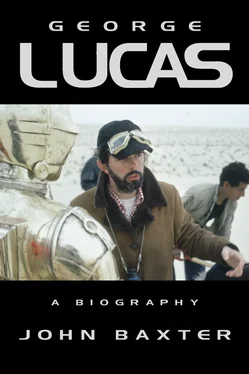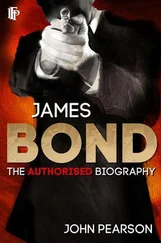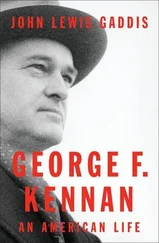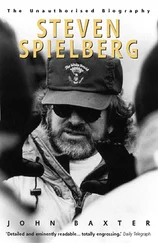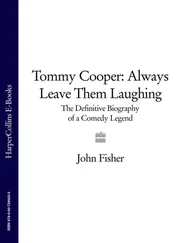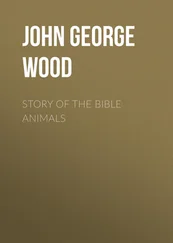His insistence on protecting his films against any interference in the cutting room would become obsessive. Friends would roll their eyes and say, ‘Lighten up, George,’ but on this he was utterly intransigent. Marcia, whom George was now desultorily dating, never came to terms with his emphasis on the sacrosanct nature of editing decisions. It wasn’t her style to walk out on a project. One stuck to it and, little by little, got one’s way. Her persistence would make her one of the most sought-after editors of New Hollywood. Producer Julia Phillips even rated her ‘the better – certainly the warmer – half of the American Graffiti team.’
‘She was an absolutely stunning editor,’ says John Milius. ‘Maybe the best editor I’ve ever known, in many ways. She’d come in and look at the films we’d made – like The Wind and the Lion , for instance – and she’d say, “Take this scene and move it over here,” and it worked. And it did what I wanted the film to do, and I would never have thought of it. And she did that to everybody’s films: to George’s, to Steven [Spielberg]’s, to mine, and Scorsese particularly. He’ll attest to the fact that she was a great editor. She was a genuinely talented film-maker. She should have become a director.’
But in 1967 people defined Marcia Griffin, as they defined most women in Hollywood, with reference to their men. She was George’s girlfriend and, eventually, wife, and very little beyond that. In general, Lucas shared that perception, as did most of New Hollywood’s husbands about their wives. Not surprisingly, divorce became the group’s norm. The first marriages of Lucas, Spielberg, Milius, Scorsese and most other newcomers of the sixties ended in divorce, their unwillingness to deal on screen with contemporary human situations replicated in their lives. Many marriages expire in the bedroom, but that of George and Marcia Lucas was rare in coming to grief in the cutting room.
Whatever claims were made later, Lucas had little or no interest in science fiction films until after he graduated from USC in August 1966. He wasn’t alone in his indifference. The doyen of Hollywood sf, George Pal, hadn’t made a movie since The Conquest of Space in 1955. The benchmark of big-budget studio science fiction, MGM’s Forbidden Planet , was a decade old. In Britain, Stanley Kubrick was preparing 2001: A Space Odyssey , but that wouldn’t be released for two years. Only starvation producer Roger Corman consistently turned out sf films, though he hadn’t actually shot one for years. It was cheaper to buy Russian or Japanese movies with lavish special-effect sequences, dump their dialogue scenes, then find some hungry young American film-maker to invent a new framing story.
Almost nobody saw these cheap sf movies in the big cities, though they cleaned up in rural drive-ins, where the twelve-to-twenty-five-year-old audience Lucas and Spielberg would inherit had begun to show its muscle. Raised on comic books and television, teenagers wanted sensational stories and gaudy special effects. When they couldn’t find them on screen, they invented them. All over the United States, amateur mask- and model-makers were painstakingly creating their own science fiction and horror films on 8mm. By the time Lucas made Star Wars , they had ripened into a generation of special-effects technicians ready to tinker together the technology he needed to realize his fantasy.
The big films of 1966 – A Man for All Seasons, Who’s Afraid of Virginia Woolf? (shot by Haskell Wexler), The Group and The Sand Pebbles – served an audience as middle-aged as the men who made them. That year’s Oscars honored mainly The Sound of Music . An unexpectedly large number of films came from Britain. In Blow-Up , Michelangelo Antonioni anatomized Swinging London, which was also exploited in Georgy Girl and Morgan: A Suitable Case for Treatment. Alfie introduced Michael Caine to an international audience. With heavy US investment, studios like Shepperton, Pinewood, and Elstree flourished in the outer suburbs of London, fostering teams of technicians who could hold their own against those of Hollywood, without the high salaries and crippling union control that made American films so expensive.
The only science fiction film of any size released in 1966 was Fantastic Voyage , an elaborate adventure in which a group of medics, including Raquel Welch, statuesque in skin-tight neoprene, are shrunk to microscopic size and injected into the body of a leading scientist to repair a brain lesion. In the days before computer technology, the effects were achieved with wires, models, and out-of-scale sets, with some very obvious back projection and matte work.
It wasn’t in cinema that science fiction was taking its steps onto the international stage, but in television. 1966 saw the debuts not only of the live-action Batman , the gadget adventure series Mission: Impossible and Britain’s The Avengers : on 8 September, the world was introduced to a phenomenon, as Captain James Kirk and the crew of the starship Enterprise boldly went where no man had gone before.
In the fall of 1966, just after he received his BA from USC, and while he was still working for Verna Fields, Lucas told Walter Murch and Matthew Robbins at a party thrown by Herb Kossower about an idea he’d had for a short science fiction film. As a first step into the fantastic, Lucas’s idea was tentative. He wondered if one could make an sf film without elaborate sets and costumes, using Los Angeles as Godard had used Paris in Alphaville , and simply suggesting the future by manipulating the image as he had in his animated USC films. If Don Glut could make Superman in the Valley, how much better might an avant-gardiste do? Lucas and Murch put together a couple of pages about an escapee from an underground civilization who emerges through a manhole into a new world; but nobody could see where it might go. Murch and Robbins developed another idea, called ‘Star Dance,’ but Lucas persisted, assembling a sort of script for a fifteen-minute film.
At this point he began to immerse himself in science fiction and fantasy. Willow , with its midget hero making an epic journey to confront the mountain fortress of an enchanter, suggests more than a nodding acquaintance with Tolkien’s Lord of the Rings . Lucas told Alan Dean Foster, who novelized Star Wars , that Conan Doyle’s The Lost World was his favorite book. Trying to explain his vision of the Star Wars films, Lucas often quoted that book’s introduction: ‘I have wrought my simple plan/If I give one hour of joy/To the boy who’s half a man/Or the man who’s half a boy.’
Frank Herbert’s Dune had a more far-reaching influence on Lucas’s future work. From the moment in December 1963 when the science fiction magazine Analog published the first of three episodes of Dune World , with its cover by John Schoenherr of a stone pinnacle spearing out of a desert landscape against a sky with two moons, the novel caught Lucas’s imagination. Once Herbert finished the longer book version and its sequels, Dune’s story of a universe based on the ‘spice’ Melange that conferred near-immortality but which existed on only one planet in the universe, the desert world Arrakis, aka ‘Dune,’ entered the common experience of his generation. Herbert imagined a universe run by the Padishah Emperor Shaddam IV, ruthlessly defending his declining empire from regional families, in particular that of Duke Leto Atriedes, whose son Paul was destined to overthrow him after acquiring near-godlike powers. Manipulating events from behind the scenes were the quasi-religious Bene Gesserit, an ancient sect of nun-like women with telepathic powers – not unlike Lucas’s monkish Jedi knights.
Читать дальше
